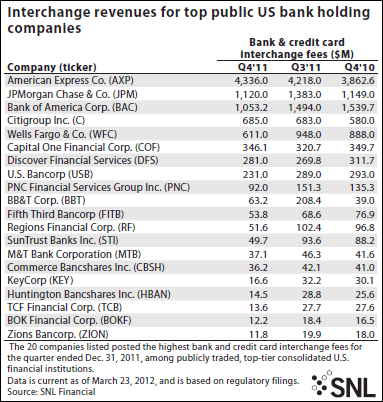Debit Interchange Fee Chutzpah

Chutzpah, according to the traditional definition, is killing your parents and then pleading for mercy, because you are an orphan. I found myself thinking about that when reading National Journal’s Stacy Kaper’s account of the latest goings-on in the lawsuit that several retail groups had filed against the Federal Reserve last year. The merchants are unhappy with what they see as the failure of Ben Bernanke’s outfit to comply with the Durbin Amendment to the Dodd-Frank act, which directed it to ensure that debit interchange fees were “reasonable and proportional.”
Well, as most of you know, the Fed fulfilled its duty by placing an upper limit of about $0.24 on the amount card issuers could charge merchants for each debit transaction they processed, which is 45 percent lower than the pre-reform average of $0.44. The upshot of the Fed’s decision was that billions of dollars ($7 billion is our estimate) of annual interchange revenue was transferred from the banking industry to the retail one. So what’s the retailers’ problem? Well, let’s hear them.
Fed Unfairly Set Debit Interchange Fees too High
That’s the main issue the retailers have with the Fed’s decision, as Kaper reminds us. But Doug Kantor, one of the lawyers representing them, puts it differently:
[I]f the Fed had written the rule correctly then there would not be these very mixed results ?Ǫ you wouldn’t have some of these negative impacts that we have seen.
The rule has indeed caused plenty of side effects, as the issuers were forced to make up for the lost interchange revenues by raising fees elsewhere. While some of their attempts have failed (spectacularly so in the case of the debit card fees tested by Bank of America and others), the cost of banking has nevertheless gone up.
So how could the Fed have written the rule so that such “negative impacts” could have been precluded? Well, Kantor doesn’t say, but he clearly believes that the interchange limit was placed too high. I don’t see how this could’ve helped anyone other than the retailers. See, courtesy of SNL Financial, we now have data on the issuers’ interchange losses in the fourth quarter of last year, which began on the day the fee limit was enacted. The table below ranks the twenty largest US card issuers by interchange revenue (debit and credit) and it shows how the total has changed on a quarterly and yearly basis.

American Express has thrived, because it doesn’t issue debit cards, but you can see how almost everyone else has been hit hard, even as other data have shown that the aggregate transaction volume has increased. Had the interchange limit been placed lower, these losses would have been greater, so the issuers would have had to be even more aggressive in their revenue recouping efforts. How could that have benefited anyone other than the retail industry?
Now, financial institutions with less than $10 billion in assets were exempted from the interchange limit, so they continued collecting interchange fees at the old rates. Naturally, as the transaction volumes grew, so did their revenues, by $507 million in Q4 2011, according to an American Banker estimate cited by Kaper. However, that amount is less than a quarter of the $2.2 billion loss suffered collectively by the bigger banks, according to the same source, so on balance the retailers have been the recipients of a $1.7 billion revenue transfer.
The Issue with Low Transaction Amounts
There is, however, a group of retailers who were genuinely hurt by the reform. As Kaper says, the interchange limit
benefited retailers who sell expensive items like flat-screen TVs and home appliances, but hurt those that sell cheaper goods and tend to register “small-ticket” transactions of $15 and less, like coffee shops, fast-food restaurants, and convenience stores.
Well, that was another one of the reform’s inevitable side effects. As it happens, we ran the numbers back in early August of 2011 and warned that “the new pricing structure will allow issuers to make more money from debit transactions in amounts of up to $11 or so than they currently do.” We used the table below to shows how the pre- and post-Durbin interchange structures compare for amounts of $5, $10, $15, $20 and $25.
| Interchange
Structures |
Transaction Amount |
||||
|
$5 |
$10 |
$15 |
$20 |
$25 |
|
| Old Interchange
1.55% + $0.04 |
$0.1175 |
$0.195 |
$0.2725 |
$0.35 |
$0.4275 |
| New Interchange
0.05% + $0.22 |
$0.2225 |
$0.225 |
$0.2275 |
$0.23 |
$0.2325 |
So yes, that was an easily predictable and predicted consequence of the reform.
The Takeaway
The Durbin Amendment represented a government-mandated transfer of revenues from one industry to another. That much has always been clear. What we have now is that the industry, which benefited from the exchange, is complaining for not getting enough. Of course, the retailers and their lawyers couch it in different terms, but the bottom line is that they want more. If the retailers won the lawsuit, we should prepare ourselves for even higher banking fees and fewer services. Fortunately, the Fed is unlikely to lose this one.
Image credit: Etsystatic.com.



Merchants claim that high interchange fees lead to high prices, and lower fees mean that retailers can pass along the resulting savings on to their customers. The problem is that the research has not supported this assertion. Customers, meanwhile, are no more than pawns in this battle between the retail and banking industries.
The Merchants Payments Coalition, which represents several retail groups and has been pushing for both credit and debit card interchange fee reform for the past few years has said that it will keep going after the issuers until they get what they want. Now, that may just be pep talk, but they may also really be in it for the long run, even as they realize that they cannot possibly win the suit against the Federal Reserve.
What the retailers argue, among other things, is that, card issuers can add in their fees the cost of updates to their payment processing equipment, which would benefit the overall bank and card issuer operations, even though these updates may not necessarily be directly traced to a specific debit card transaction. The merchants claim that this runs against the Durbin Amendment. I think they have a point.
I’m with the retailers in this one. The Federal Reserve allowed itself to be influenced by the banks which they are supposed to regulate and supervise and raised the initially proposed limit to include fees which were not allowed by the law. So what they did was that they gave away half the savings that could have been received by merchants and, yes, consumers, despite what you write in your article. The Fed should go back and follow the law.
The irony is that even though smaller banks and credit unions are exempt from the debit interchange cap, they will still be affected negatively by it, as it creates a two-tiered system in which larger card issuers are offering merchants lower prices. So merchants may end up rebelling against the smaller issuers, if all else fails.
I’m amused by the side effect the Durbin Amendment is having on small-ticket merchants. Some of them, practically all coffee shops, will be hit very hard, even as their neighboring businesses rack in the savings. There was no need for all that and Congress should have stayed away from it.
The final version of the Federal Reserve’s debit fee limit provided a loophole for the big card issuers to exploit and actually raise some fees. The Fed’s sole responsibility was to implement the Durbin Amendment as it was written, and it plainly failed to do that. And as others have pointed out, the increase in the interchange rates on small-ticket transactions is a particularly outrageous example of the Fed’s failure.
It should be clear to everyone paying attention to this thing that the merchants won’t be happy until they pay precisely zero to accept both debit and credit cards. They do want their customers to have access to these payment instruments, but they certainly do not want to pay their share of what’s needed to keep the payment system running. That’s not going to work.
Credit cards were not regulated by the Durbin Amendment, even though their interchange fees were on average much higher than the debit interchange fees even before the limit was enforced. That was a mistake that needs to be corrected and credit card fees should go down. I mean, if banks were doing so badly, how would they have been able to afford maintaining the incredible rewards programs that you’ve been writing about on this blog?
As you know, this is not the first time the Federal Reserve has been sued over the debit interchange limit. Back in 2012 TCF Bank was the first to file a suit against the Fed arguing that the Durbin Amendment was unconstitutional. TCF had to drop the suit in July of last year, following the publication of the Federal Reserve’s final rules and also because TCF failed to secure a preliminary injunction to prevent the interchange reform from taking effect.
Hello Frank,
Yes, we did actually wrote about the TCF lawsuit back when it was filed a year and a half ago. It never had much of a chance and I suspect that the current suit will end up in the same way.
Retailers got $8 billion dollars a year in additional revenues, which it seems to me is something they should be happy about. I also think that they should have passed some of this money on to their customers, as they promised. Why should they be given even more when they simply end up keeping everything for themselves. Where is the consumers’ gain in all that (we already know where the downside is)?
Small business and consumers are in fact hurting from this. Research based on larger companies doesn’t show what it’s doing to the companies already struggling, the small types that started America.
Here is one business owners example, as he sees it, just another wasteful contribution to the end small business. It’s not savings to pass in his case, its expenses to cover in the shrinking margins of big business competition
Stef,
I respect your position and you are correct that some businesses are hurting, especially smaller ones whose owners do not always understand the type of pricing to which they agree with their processor. One of our goals with this blog is to help educate merchants, so that they can make better decisions when it comes to selecting the best payment processor and hope that some will find it helpful.
I have removed your link to the YouTube video, because it is inappropriate.
You talk about the transfer of wealth from one industry(Banking) to an other(Retail) and the merchants. What about the service providers? They are certainly a player in these transactions and by varying rates they can offset what ever savings the merchants are entitled to enjoy.